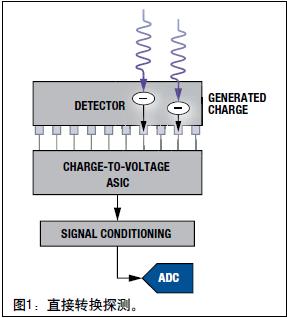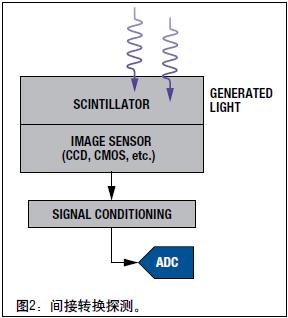Digital X-rays are changing the way radiology works. This technology reduces patient radiation exposure, improves diagnostic image quality, and reduces thousands of dollars in chemical processing costs compared to traditional X-ray systems.
This article refers to the address: http://

The shaping of digital X-rays can be divided into direct conversion and indirect conversion. Direct conversion uses a selenium-based panel to convert non-absorbed photons directly into charge, as shown in Figure 1. Indirect conversion uses a scintillating material to convert photons into light, and then converts the light into an electrical signal using a photodiode, CCD, or CMOS imaging sensor, as shown in Figure 2. Regardless of how the X-ray energy is converted into an electrical signal, it must be converted from an analog signal to a digital signal for image processing. Although the update rate of the entire image is relatively low (15 to 120 frames per second), the detector contains millions of pixels, enabling accurate conversion of high-speed signals and readings while maintaining low cost and low power consumption. High precision is a challenge that needs to be addressed.


solution
Both direct and indirect conversion of the signal requires an ADC whose sampling rate should be equal to the product of the array size and the update rate. The most cost-effective and lowest-power solution is to digitize each pixel in turn using one or more high-speed ADCs. Large detectors may require several analog to digital converters to digitize the image at the desired update rate.
While standard image intensifier tubes provide depths from 8 bit to 10 bits, the new detectors have a wider dynamic range, using 14-bit, 16-bit or even 18-bit analog-to-digital converters. With improved dynamic range and improved sensitivity, these filmless detectors produce higher quality images and bring more information to the diagnosis. In addition to improving the raw data needed for diagnostics, digital processing can also increase contrast and highlight differences in tissue density.
Analog Devices offers a range of high speed, high resolution ADCs to meet a wide range of detector array sizes and update rates. For the highest signal-to-noise ratio, the AD762116-bit PulSAR ADC has a signal-to-noise ratio (SNR) of 90dB and a slew rate of up to 3MSPS. For systems with lower dynamic range, the AD7484 14-bit SAR ADC has a signal-to-noise ratio (SNR) of 76.5 dB at 3 MSPS sampling rate. Both the AD7621 and AD7484 are successive approximation analog-to-digital converters with excellent linearity, which is an important parameter for image quality. For higher speed ADCs, the AD9240 and AD9244 14-bit single-chip ADCs provide sample rates of 10MSPS and 40MSPS/65MSPS, respectively. These pipelined ADCs are ideal for X-ray equipment where the entire image requires a high update rate.
Mono panel,High Quality Mono panel,Mono panel Details, Yangzhou Bright Solar Solutions Co., Ltd.
Yangzhou Bright Solar Solutions Co., Ltd. , http://www.cnbrightsolar.com
